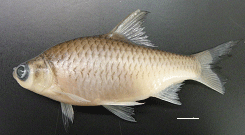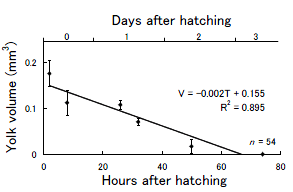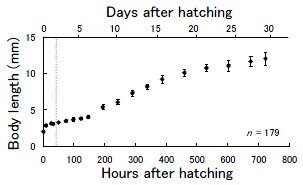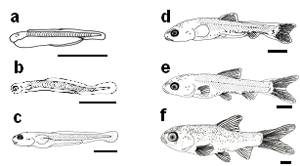Seed production and growth of Laotian cyprinid Hypsibarbus malcolmi, a high-potential aquaculture target species
Description
In Laos, aquaculture has been promoted in recent years due to necessity arising from the increase of fish demand as a recent development of the expanding national population. However, the aquaculture production of the country at present is largely dependent on alien fishes (> 80%), e.g., the tilapia Oreochromis niloticus. In consequence, the invasive settlement of such species in the region has progressed, this settlement leading to a concern of possible disruption /decline in indigenous fish fauna, although total aquaculture production has rapidly increased due to the aquacultural utilization of such alien species. Considering this situation, further development of indigenous fish aquaculture in the region is now required. Hypsibarbus malcolmi (Cyprinidae, Fig. 1) is widely distributed in the Indochinese Peninsula, including Laos, and is a common marketable fish species, but it has not been used for aquaculture so far. In this study, therefore, we attempted artificial seed production, examined its productivity, and described the growth and morphological development of the species.
Through the experimental trial on seed production of Hypsibarbus malcolmi, the following results were obtained: (1) ca. 100,000 fertilized eggs per female (600–1,000g) were obtainable by means of an LH-RH analogue hormone injection. (2) The larvae consumed the yolk completely on Day 2 after hatching at the average size of 3.3 mm in body length (BL) (Figs. 2, 3), and started feeding. (3) Artificially produced rotifers (Brachionus spp.) were sufficient initial diet, and high feeding incidence rate was observed (100% on Day 3). (4) Fish shifted from the larval to juvenile stages at 10.4 mm BL with completion of aggregated fin rays (Fig. 4). (5) No cannibalism took place and high survival (> 90%) rate was observed within 30 days of rearing since hatching.
As shown above, the high fecundity of adult Hypsibarbus malcolmi and high survival during the early developmental period (larval and juvenile stages) represent the exceptional applicability of the species for seed production and aquaculture; these features being sufficient for technical transfer to private seed producers. In addition, the morphological information obtained here is contributory to species identification of Hypsibarbus malcolmi among various sympatrically distributed cyprinids. On the other hand, other factors adequate for aquacultural operation (e.g., feed conversion rate, disease tolerance), growth under aquacultural conditions until harvest and their extension to private farmers are still to be investigated not only for Hypsibarbus malcolmi but for the other species (total of nine species) in which seed production trials have so far been experimentally successful with the cooperation of JIRCAS.
Figure, table
-
Fig. 1. Hypsibarbus malcolmi (110 mm BL).
Scale bar: 10 mm. -
Fig. 2.
Growth of Hypsibarbus malcolmi larvae and juveniles (dotted line: complete absorption of yolk, error bars: standard deviations). -
Fig. 3.
Yolk absorption pattern in Hypsibarbus malcolmi larvae (error bars: standard deviations, V: yolk volume, T: hours after hatching). -
Fig. 4. Hypsibarbus malcolmi larvae and juveniles.
a larva at hatching (yolksac period, 1.9 mm BL), b Day 1 larva (yolk sac period, 3.0 mm BL, c Day 6 larva (flexion period, 4.4 mm BL), d Day 12 larva (flexion period, 7.3 mm BL, e Day 16 larva (post flexion period, 9.1mm BL), f Day 30 juvenile (12.9 mm BL). Scale bar: 1 mm.
- Affiliation
-
Japan International Research Center for Agricultural Sciences Fisheries Division
- Classification
-
Administration B
- Term of research
-
FY2006~2010
- Responsible researcher
-
Morioka Shinsuke ( Fisheries Division )
KAKEN Researcher No.: 40455259OGATA Yuka ( University of Tokyo )
SANO Kousuke ( University of Tokyo )
Vongvichith Bounsong ( Living Aquatic Resources Research Center, Lao PDR )
EDA Hiroki ( IC Net Limited )
KUROKURA Hisashi ( University of Tokyo )
KHONGLALIANE Thongkhoun ( Department of Livestocks and Fisheries, Lao PDR )
- ほか
- Publication, etc.
-
Ogata et al. (2010) Ichthyological Research 57:389-397.
- Japanese PDF
-
2010_seikajouhou_A4_ja_Part21.pdf420.31 KB




